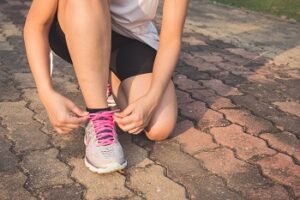New research in exercise and eating disorders
New research in exercise and eating disorders

by Alanah Dobinson, Accredited Exercise Physiologist
Exercise serves a different purpose for everyone. What is your purpose when you exercise? Some of us use exercise to de-stress; some of us use it to improve our health. However, some people utilize exercise for punishment, or are reliant on it to regulate their emotions. Others continue to exercise despite being unwell, which can exacerbate physical and psychological complications. And some of us completely abstain from exercise due to experiencing traumatic events related to our body or exercise in the past. We all have unique reasons why we do and do not exercise with an eating disorder (ED).
The facts*
Up to 80 per cent of people with Anorexia Nervosa engage in excessive, compulsive exercise leading to increased risk of both disability and death. Harmful exercise engagement often precedes the onset of the ED and is one of the last symptoms to subside. Dangerous exercise exacerbates the risk of cardiovascular issues, vital organ dysfunction, bone damage, reproductive issues, muscular and metabolic issues, relapse/delayed recovery and takes away time from family and friends, work, study, and other important areas of one’s life. Conversely, exercise abstinence can be dangerous as it may cause secretive/dangerous exercise engagement, allow exercise beliefs to remain unchanged, and worsen musculoskeletal and cardiometabolic consequences.
Creating exercise guidelines
The first comprehensive medical and psychological exercise guidelines for eating disorders will be available for global use from April 2018. These guidelines, “SEES: Safe Exercise at Every Stage” for eating disorders, have been formed by clinicians and researchers in Australia, with the help of eating disorder experts around the world. They will include a flow chart of when, how, what and why exercise progression or regression is required at every stage of your eating disorder, using medical and psychological parameters as a guide. An array of movement and exercise psychology tasks can be completed, regardless of the stage of recovery or relapse you may be in. There is already a large amount of interest in these guidelines across all settings in many countries. These will be ready for use in April 2018 at cfih.com.au and must only be used with the involvement of your treatment team.
Answers to common questions
What is dangerous exercise?
- Overexercising, exercising in secret, and engaging in rigid/repetitive or punitive exercise
- Exercise that is directly related to the ED voice, as self-harm, or for caloric compensation
- Purging through vomiting, laxative use, insulin abuse or exercise, caloric restriction, and exercise performed despite injury or illness
- Experiencing guilt, anxiety and low mood pertaining to exercise, and distorted exercise beliefs
- Exercise that interrupts daily life, or when excessive time is spent thinking about exercise
- Perceived inability to change exercise session or introduce anything new
What questions can I ask myself to check if I am exercising dangerously?
- Do I feel guilty if I miss my workout?
- Do I still exercise when I am sick or hurt?
- Do I miss going out with friends or spending time with family, just to ensure I can complete my workout?
- Do I feel anxious or agitated if I miss a workout?
- Do I calculate how much to exercise based on how much I eat?
- Do I have trouble sitting still because I’m not burning calories?
- If I’m unable to exercise, do I feel compelled to cut back what I eat that day?
If one or more of these are ‘yes’, dangerous exercise engagement may be occurring and your treatment team must be notified for further exploration.
Why do I exercise so much, or not at all?
Exercise serves several purposes in an eating disorder. Often, people who have perfectionistic tendencies and low self-esteem, and those who engage in strict dieting, binge eating and purging, can use exercise as a crutch or outlet during their ED journey. Some of us are dependent on the mood-changing effects of exercise, and others exercise as we have extreme concerns about the perceived negative consequences of stopping or reducing exercise (such as weight gain). Also, some of us may use exercise as a coping strategy to temporarily silence the bullying of the eating disorder (by giving in and exercising, to feel less guilty, which is known as avoiding negative affect). Further, some people feel they must punish themselves for eating or for being a “bad person.” On the flip side, some of us completely avoid exercise as we are ashamed of our bodies, do not trust our bodies, or have had traumatic experiences in the past relating to exercise or our bodies.
What should safe, healthy exercise engagement look like?
Calegoro and Pedrotty (2004) summarise what exercise should be used for, via the Physiotherapeutic Approach. Exercise must:
- “Rejuvenate the body, not exhaust or deplete it”
- “Increase mind-body connection, not allow or induce disconnection”
- “Alleviate mental and physical stress, not produce more stress”
Any exercise engagement that does not fit with the Physiotherapeutic Approach is not appropriate for improving well-being – it actually detracts from it. It is important that your treatment team monitors your physical and psychological state as often as required through psychological examinations, blood tests, EKGs, vital reading examinations and dietetics appointments.
What is the optimal amount of exercise I should engage in?
This is a question for you as the person living with the ED, your family/friends/carer, and your entire treatment team to answer together. All variables must be considered from all angles before deciding. These variables can include, whether your exercise follows the Physiotherapeutic Approach, your current psychological and medical state, your relationship with exercise, your purpose for exercising, and the amount of exercise you used to do. This question requires a team effort to answer, and must be reviewed often (weekly to monthly) to ensure any changes are made appropriately to keep you safe.
Reach out for guidance
There are many considerations in relation to exercise engagement and your ED. If you have any questions, queries or concerns about your dis/engagement in exercise, or you want to seek help, raise this with your treatment team, or contact the Academy for Eating Disorders: https://www.aedweb.org/index.php/education/eating-disorder-information/eating-disorder-information-2.
About Alanah:
Alanah Dobinson is an accredited exercise physiologist (AEP) who works within the eating and weight concerns field. Alanah works at Centre for Integrative Health (CFIH) in Australia, which is a unique private, outpatient, multidisciplinary team of psychologists, dietitians and exercise physiologists helping people recover from eating disorders. Alanah and her colleagues, Sarah King (AEP at SK Active) and Marita Cooper (Psychologist at CFIH), are creating the first clinical exercise guidelines for people with an eating disorder, called “SEES: Safe Exercise at Every Stage” for eating disorders. These guidelines, due for release in April 2018, are based on both a systematic review of the literature, and international focus groups involving relevant world experts. For more information, email info@cfih.com.au.
*The Facts reference list (in order)
- Fietz, M., Touyz, S. and Hay, P. (2014). A risk profile of compulsive adolescents with an eating disorder: a systematic review. Advances in Eating Disorders, 2(3), 241-263.
- Crisp, A., Hsu, L., Harding, B., and Hartshorn, J. (1980). Clinical features of anorexia nervosa: A study of a consecutive series of 102 female patients. Journal of Psychosomatic Research, 24, 179-191. Giordano, C. (2005). Understanding eating disorders, Oxford: Oxford University Press, Chs 5 & 6.
- Ng, K., Kuek, A., and Lee, H. (2013). Eating psychopathology and psychosocial impairment in eating disordered individuals – a Singapore study. Journal of Eating Disorders, 1(Suppl 1):O68
- Moola, F., Gairdner, S., Catherine, E. and Amara, B. (2013). 6 (Exercise in the care of patients with anorexia nervosa: A systematic review of the literature. Mental Health and Physical Activity, 6. 59-68.






Jennifer Aviles writes via email:
I was so glad to read about this study and the thoughtful conclusions. I am one of those people who struggled with anorexia subtype bulimia and when I was introduced to long distance running, I discovered it caused me to reconnect with my body. Running was what turned me around. I believe there are others like me who would be able to use exercise as a way of getting into recovery.
Thank you for posting this.
Thank you for sharing your experience with an eating disorder and the impact, effect and role of exercise not only in your illness but in your recovery and ongoing wellbeing, Jennifer.